
NPS photo
The Sonoran Desert has earned a reputation for its very hot summers and warm winters, but it is also the wettest desert, with two rainy seasons. This combination of heat and rain provides the perfect storm for colorful flowers during every season. The unique soil and climate cultivates plants that are not only beautiful but provide medicinal and cultural uses. Explore some of the wildflowers found in the monument below.
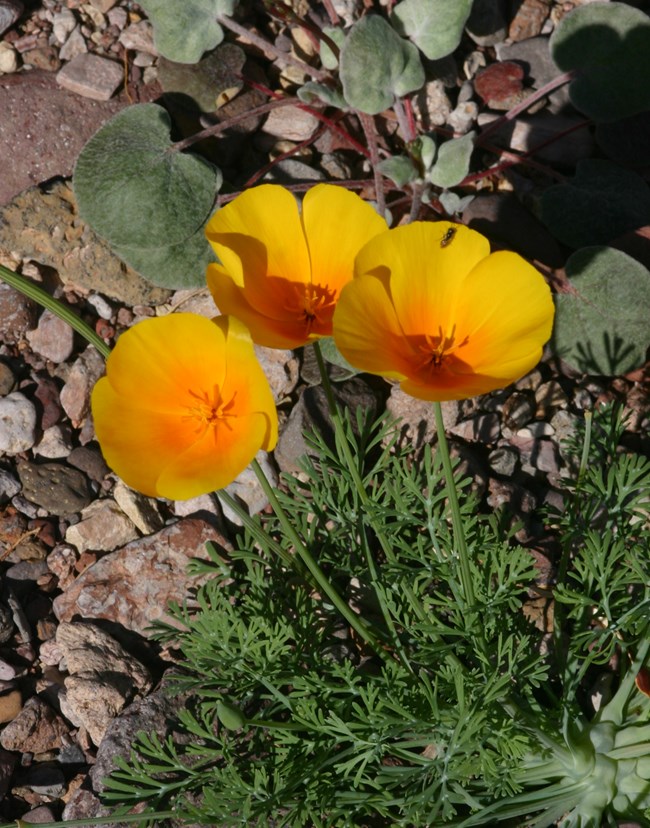
NPS Photo Mexican gold poppy (Escholzia californica mexicana)In the early spring, Mexican gold poppies pop up throughout the monument. After a particularly wet winter, this flower will blanket the landscape in gold. It was traditionally used to soothe toothaches and headaches, as well as to relieve anxiety and promote sleep. Identify this FlowerThis small plant grows 6-18 inches tall (15-45 cm), and can often be found in sprawling patches. Between February and April, look for showy yellow blooms with a slightly orange center. Deeply divided, blue-green leaves grow in a small bush beneath the long flower stems. Delicate petals furl shut at night or on overcast days. 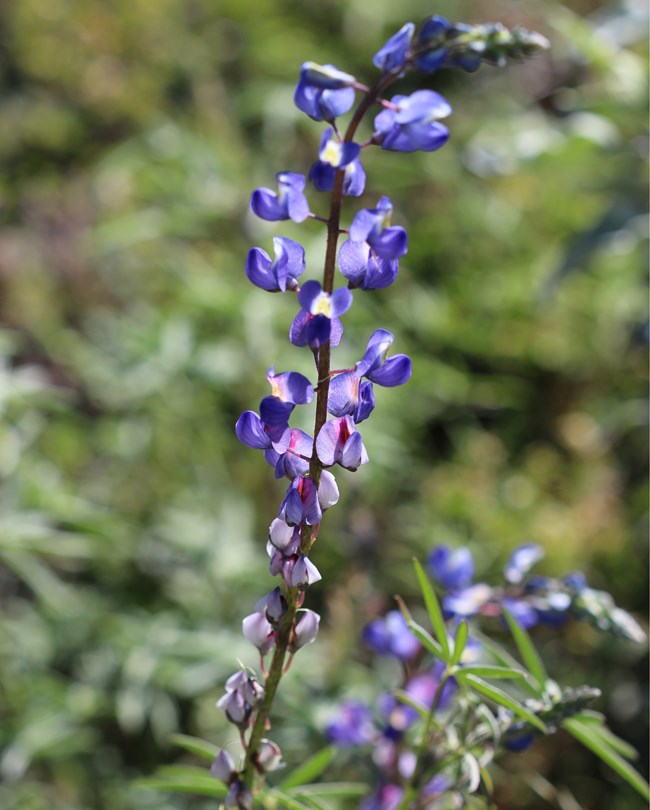
NPS Photo Desert lupine (Lupinus sparsiflorus)Desert lupine is a distinct spring wildflower that occurs at lower elevations in the Sonoran Desert. Lupine provides important ground cover for small animals and the seeds are a food source for birds. These flowers are highly dependent upon native bee species for pollination. Identify this FlowerThis 8-16 inch tall (20-40 cm) plant sends up a shoot of indigo flowers in the spring. Leaves are palm shaped, with 7-11 leaflets that fold down the middle, extending from the same point on a stem. At elevations higher than 3000 feet (915 m), you may come across Arizona lupine (Lupinus arizonicus), which looks like desert lupine but with bright magenta blooms. 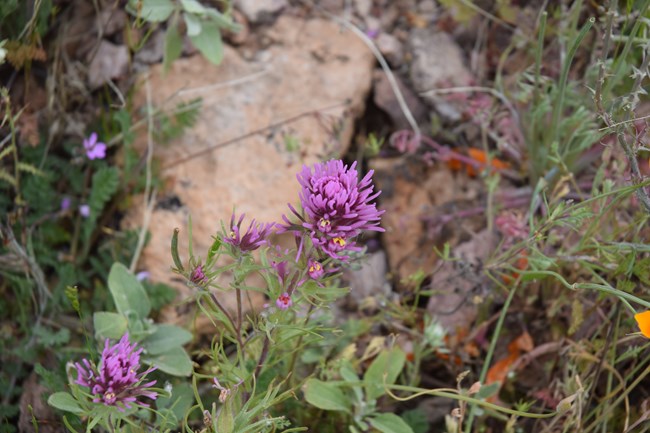
NPS Photo Purple owl’s clover (Castilleja exserta)Though this plant looks like a clover at first glance, it is instead related to “paintbrushes”. Their upper leaves are tipped with the vibrant color, making it look like it was “dipped in paint”. This plant taps into the roots of other plants such as desert lupine and Mexican gold poppy to meet some of its nutritional needs, making it a “hemiparasite”. Identify this FlowerPurple owl’s clover grows 4-18 inches tall (10-45 cm). Leaves are thin, finely branched, and delicate. The magenta to white bloom of purple owl’s clover is made up of uniquely shaped flowers, interspersed with leaves. Seeds are contained in a small capsule. 
NPS Photo Globemallow (Sphaeralcea sp.)Globemallows are a group of showy, flowering plants that carpet the Sonoran Desert in a wash of color in winter. Traditionally, parts of these plants were used as medicine to alleviate symptoms of colds and flus. These hearty plants grow well in crusty desert soil or “desert pavement”, where other plants can’t grow, and are some of the earliest blooms in the area. Identify this FlowerGlobemallows are tricky to tell apart, unless looking specifically at flower color and leaf shape. These flowers will typically grow 12-36 inches tall (30-90 cm), and are highly branched, giving the plant a spiky appearance from a distance. Leaves are heart or triangle-shaped, and may be deeply lobed and fuzzy. The petals create a signature bowl shape, and are typically orange, red, or pink in color, with a distinct mound in the center. Seed pods are uniquely disc like and separate in pie-like “slices”. The most common species in our area are S. ambigua, laxa, and emoryi. 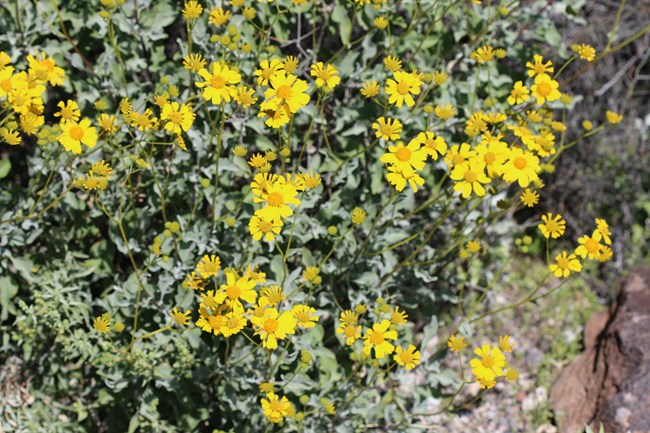
NPS Photo Brittlebush (Encelia farinosa)Brittlebush is especially common along roadsides, where a little extra run-off may cause some plants to produce occasional out-of-season blossoms. Brittlebush contains an aromatic resin that was burned by Spanish missionaries as incense; because of this, it is also known as “incienso”. Traditionally the sap has been used as a glue, varnish, and chewing gum, as well as a remedy for toothaches. Identify this FlowerBrittlebush grows up to 3 feet tall (1 m), and is usually a dense mound. Leaves are a distinct round diamond shape and wooly. Flowers are yellow with many petals, appearing "daisy-like". Brittlebush can be recognized when not in bloom by the halo of dried flower stems that extend above the leaf-bearing branches. 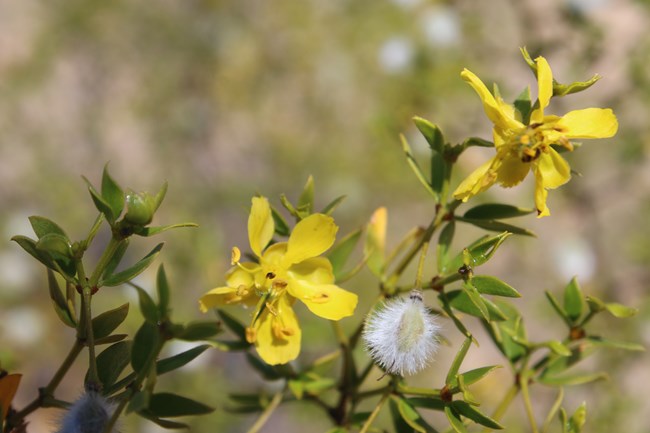
NPS Photo Creosote bush (Larrea tridentata)Creosote is one of the most common shrubs in the monument and is a member of the "creosote bush scrub" community of plants in the Sonoran and Mojave deserts. This aromatic shrub is evenly spaced along with burrobush and triangle-leaf bursage in the flat valleys between mountain ranges. A chemical on the leaves produce a tar-like scent when humidity is high, causing human inhabitants of the Sonoran and Mojave Deserts to associate the distinct smell with rain. On a dry day, you may breathe on leaves to mimic humidity and experience the smell of desert rain. Identify this FlowerLook for small thick leaves shaped like pointed ovals with two sprouting from a bud. Creosote flowers are bright yellow with five rounded petals and a protruding center. The fruit appears as small fuzzy white balls. Creosote grows 3-10 feet tall (1-3 m). More About Sonoran Desert Plants |
Last updated: August 11, 2023
